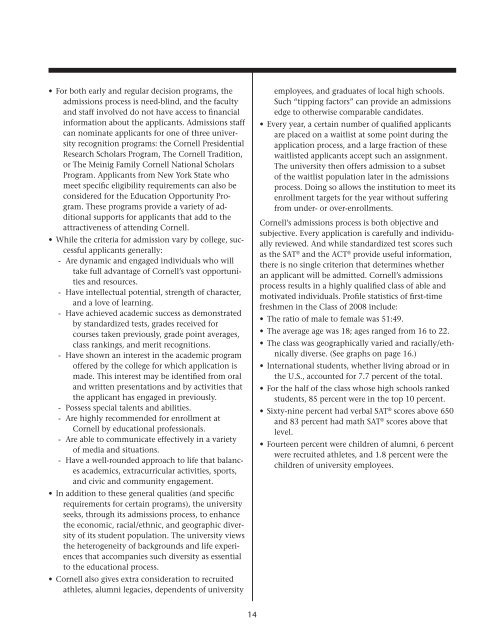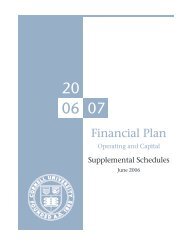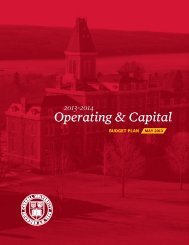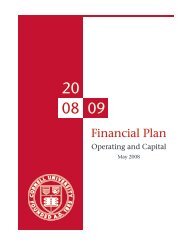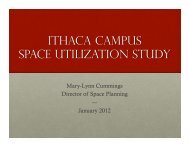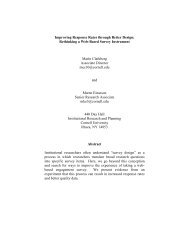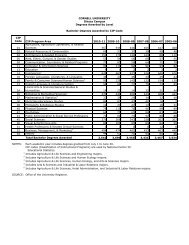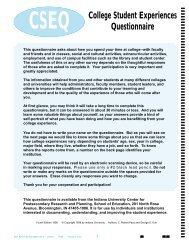<strong>Cornell</strong> subscribes to several <strong>of</strong> these nine “philosophicalperspectives” as its enrollment process is designedto meet its enrollment goals while enhancing theoverall quality <strong>of</strong> the students’ educational experience.The university seeks to promote the greater good andfurther the development <strong>of</strong> society at large, and accessto its programs is granted to those who have excelledacademically and demonstrated service to their communities.The university believes in the view thathigher education is a “great equalizer” and strives toensure that the student body is diverse in many ways.Perfetto, et al. noted further that:Despite what the popular press and various guidebookswould suggest, gaining admissions to college is not equivalentto finding your place on the food chain. If one mustuse a biological metaphor, a more appropriate analogywould be finding your niche in an ecosystem. Differentinstitutions aspire to serve different educational needs, anddifferent students will have their educational needs servedbest by different types <strong>of</strong> colleges. A particular institution’sdecision <strong>of</strong> whom and how to admit—its admission modelif you will—must be related to the societal role that itelects to play.Finally, these authors describe the intricacy <strong>of</strong> theadmissions process.…The “best practice model” for making admissions decisionscan only be derived after a careful review <strong>of</strong> themission <strong>of</strong> a particular institution, and only after consideringan institution’s constraints and available resources.Furthermore, a majority <strong>of</strong> institutions employ severaldifferent decision-making models, either simultaneouslyor sequentially. What at first glance appears to be a simpleprocess is in reality a very complex process, each institutionrepresenting a unique compromise between competingvalues and priorities.Admissions at <strong>Cornell</strong><strong>Cornell</strong>’s admissions process allows the university tosift systematically through the 25,000-plus applicationsthat are received every year for access, as firsttimefreshmen and transfer students, to its undergraduatedegree programs. As the university enrolls a littleover 3,000 first-time freshmen every year and about600 students who transfer from other institutions,the winnowing process is significant. The admissionsprocess is even more complicated due to <strong>Cornell</strong>’stradition <strong>of</strong> allowing each <strong>of</strong> the seven colleges withundergraduate enrollments a degree <strong>of</strong> autonomy inestablishing college-specific enrollment goals (such aswomen students in the College <strong>of</strong> Engineering or studentsfrom farm families in the College <strong>of</strong> Agricultureand Life Sciences) and an active participation <strong>of</strong> thosecolleges in recruitment and admissions processes. Yetdespite this complexity <strong>Cornell</strong> operates with a coordinatedand highly focused admissions process.• Enrollment goals for first-time freshmen students areestablished for each <strong>of</strong> the seven undergraduatecolleges. (See enrollment management, page 8.)• Currently, applicants apply to a single <strong>Cornell</strong>college † under one <strong>of</strong> two application options:(a) early decision, where an application is filed byNovember 1st and a decision is made in mid-December, and (b) regular decision, in which theapplication is filed by January 1st and a decision ismade between February and April.• The Early Decision Program (EDP) is designed forapplicants whose first choice is <strong>Cornell</strong>, and theapplicant, if accepted by the university, is requiredto enter into an agreement to attend, withdrawingall applications that may have been made to otherinstitutions. Between 30 and 40 percent <strong>of</strong> thefreshman class is admitted under this program,and its applicants have a slightly better chance <strong>of</strong>gaining admission as their enthusiasm for <strong>Cornell</strong>is considered a plus among decision factors. OnceEDP admissions are determined in December theuniversity begins its regular decision process.• While timing varies between the two options theprocess for both is similar:- Applications are received and processed centrallyand then distributed to the specific college towhich the applicant has applied.- In the colleges, applications are reviewed by collegeadmissions staff members, central admissionsstaff members who have been assignedas readers, and (in some colleges) faculty. Mostapplications are read by two individuals; somereceive reviews by four or five faculty/staffmembers.- Studio programs—such as art, architecture, andinterior design—require or recommend apersonal interview to permit a review <strong>of</strong> the applicant’sportfolio <strong>of</strong> previous and current work.The School <strong>of</strong> Hotel Administration employspersonal interviews to gauge student interest inthe hospitality discipline.† See third bullet on page 19 concerning a planned change.13
• For both early and regular decision programs, theadmissions process is need-blind, and the facultyand staff involved do not have access to financialinformation about the applicants. Admissions staffcan nominate applicants for one <strong>of</strong> three universityrecognition programs: the <strong>Cornell</strong> PresidentialResearch Scholars Program, The <strong>Cornell</strong> Tradition,or The Meinig Family <strong>Cornell</strong> National ScholarsProgram. Applicants from New York State whomeet specific eligibility requirements can also beconsidered for the Education Opportunity Program.These programs provide a variety <strong>of</strong> additionalsupports for applicants that add to theattractiveness <strong>of</strong> attending <strong>Cornell</strong>.• While the criteria for admission vary by college, successfulapplicants generally:- Are dynamic and engaged individuals who willtake full advantage <strong>of</strong> <strong>Cornell</strong>’s vast opportunitiesand resources.- Have intellectual potential, strength <strong>of</strong> character,and a love <strong>of</strong> learning.- Have achieved academic success as demonstratedby standardized tests, grades received forcourses taken previously, grade point averages,class rankings, and merit recognitions.- Have shown an interest in the academic program<strong>of</strong>fered by the college for which application ismade. This interest may be identified from oraland written presentations and by activities thatthe applicant has engaged in previously.- Possess special talents and abilities.- Are highly recommended for enrollment at<strong>Cornell</strong> by educational pr<strong>of</strong>essionals.- Are able to communicate effectively in a variety<strong>of</strong> media and situations.- Have a well-rounded approach to life that balancesacademics, extracurricular activities, sports,and civic and community engagement.• In addition to these general qualities (and specificrequirements for certain programs), the universityseeks, through its admissions process, to enhancethe economic, racial/ethnic, and geographic diversity<strong>of</strong> its student population. The university viewsthe heterogeneity <strong>of</strong> backgrounds and life experiencesthat accompanies such diversity as essentialto the educational process.• <strong>Cornell</strong> also gives extra consideration to recruitedathletes, alumni legacies, dependents <strong>of</strong> universityemployees, and graduates <strong>of</strong> local high schools.Such “tipping factors” can provide an admissionsedge to otherwise comparable candidates.• Every year, a certain number <strong>of</strong> qualified applicantsare placed on a waitlist at some point during theapplication process, and a large fraction <strong>of</strong> thesewaitlisted applicants accept such an assignment.The university then <strong>of</strong>fers admission to a subset<strong>of</strong> the waitlist population later in the admissionsprocess. Doing so allows the institution to meet itsenrollment targets for the year without sufferingfrom under- or over-enrollments.<strong>Cornell</strong>’s admissions process is both objective andsubjective. Every application is carefully and individuallyreviewed. And while standardized test scores suchas the SAT ® and the ACT ® provide useful information,there is no single criterion that determines whetheran applicant will be admitted. <strong>Cornell</strong>’s admissionsprocess results in a highly qualified class <strong>of</strong> able andmotivated individuals. Pr<strong>of</strong>ile statistics <strong>of</strong> first-timefreshmen in the Class <strong>of</strong> 2008 include:• The ratio <strong>of</strong> male to female was 51:49.• The average age was 18; ages ranged from 16 to 22.• The class was geographically varied and racially/ethnicallydiverse. (See graphs on page 16.)• International students, whether living abroad or inthe U.S., accounted for 7.7 percent <strong>of</strong> the total.• For the half <strong>of</strong> the class whose high schools rankedstudents, 85 percent were in the top 10 percent.• Sixty-nine percent had verbal SAT ® scores above 650and 83 percent had math SAT ® scores above thatlevel.• Fourteen percent were children <strong>of</strong> alumni, 6 percentwere recruited athletes, and 1.8 percent were thechildren <strong>of</strong> university employees.14


